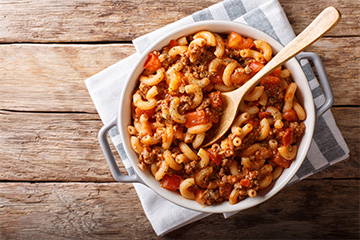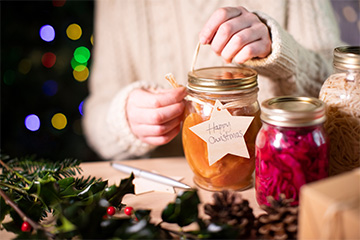
Goulash

Remember when goulash was the go-to dish for families? It’s popular again – many social media posts reminisce about moms, grandmas and school cooks who served traditional goulash. If you’re considering home canning your own, here is a great tested and safe recipe to get you started!
Note: Do not add pasta to goulash before processing. Add pasta only when preparing the dish for a meal.
Ingredients:
- 2 to 3 pounds of lean ground beef or turkey
- 1 large onion, chopped
- 1 cup chopped peppers, variety of choice (hot or bell peppers)
- 6 cloves minced garlic
- 3 tablespoons Worcestershire sauce
- 3 cups tomato sauce or 2–3 quarts whole peeled tomatoes
- 1 teaspoon cayenne pepper or red pepper flakes
- 1 teaspoon thyme
- 1 teaspoon cumin
- 1 teaspoon chipotle seasoning
- 2 teaspoons dry mustard
Instructions:
- Brown the ground beef (or turkey) with onion and peppers, and then add minced garlic. Season with salt and pepper to taste. Be sure to drain well.
- Combine meat mixture, Worcestershire sauce, tomatoes and seasonings in a large saucepan. Simmer for 30 minutes.
- Ladle into clean, hot canning jars, leaving 1 inch of headspace. Remove air bubbles. Wipe rim. Apply flat (lid) and screw band until fingertip-tight.
- Process pints for 75 minutes at 10 pounds pressure (11 pounds for a dial-gauge canner) and quarts at 90 minutes. Makes 4 pints or 2 quarts.
To serve:
- Place goulash in a saucepan over medium heat. Bring to a simmer, and add additional spices to taste. Add a bit of brown sugar if a hint of sweetness if desired.
- While sauce is simmering, in a separate saucepan cook pasta of choice and drain excess water well. Add pasta to the goulash mixture and mix thoroughly.
Source:
Ball Corporation. 2011. Let’s Get Canning.
Choose Your Pasta

- Long and skinny pasta — that is, spaghetti, linguine and vermicelli — are best for light sauces and cream- or oil-based sauces.
- Long ribbon pasta — that is, fettuccine and pappardelle — are great choices for rich, meaty sauces.
- Tube pasta — that is, penne, rigatoni and macaroni — are best used for thick vegetable sauces or baked dishes.
- Twist pasta, such as fusilli, work best with light sauces, such as pesto.
- Shell pasta — that is, conchiglie or lumache — are good in heavy cream or meat sauces.
- Mini pasta, such as orzo, are best in soups and salads.
- Filled pasta — that is, ravioli or tortellini — are traditionally served with a light butter or oil sauce.
Safety Considerations for Gifts of Home-Canned Foods

Home-canned foods are thoughtful gifts during the holidays or anytime. But how do you know if the food product you received as a gift is safe to eat? Use these tips based on National Center for Home Food Preservation guidelines to evaluate the safety of home-canned gifts.
- Fruit jams and jellies and whole fruits like peaches and pears are low-risk because their natural acidity and high sugar content provide an extra measure of safety.
- Low-acid meats, vegetables and mixtures pose a higher risk, because, if improperly processed, they can support the growth of the botulism bacteria. These products must be prepared following tested recipes in a pressure canner.
- Mixtures of acidic and low-acid foods — such as salsas and some pickled products — are also a potential risk for botulism if they are not properly processed. Jar size is important to home-canned food safety, as well. For example, while you can safely can salsa in pint jars, you won’t find any tested recipes for safely canning salsa in quart jars.
Not everything that is made commercially can be safely canned at home. For example, there are no tested procedures for home canning the following products:
- Pesto
- Pumpkin butter or other vegetable-based butters
- Cream soups
- Hot fudge sauce
- Canned breads and cakes
- Herbs or vegetables in oil
- Gifts canned in decorative untested jars
A sealed lid doesn’t mean a product is safe. It is best when the gift giver uses recommended recipes, procedures and equipment. Ask a few kind questions, if necessary. Be gracious and thankful for the gift, but if there is any doubt about a product’s safety — throw it out.
Source:
Andress, Elizabeth L. 2010. “Be Safe Eating Your Homemade Gifts.” National Center for Home Food Preservation.